Class 12 Physics Electric Charges And Fields Multiple Choice Questions And Answers
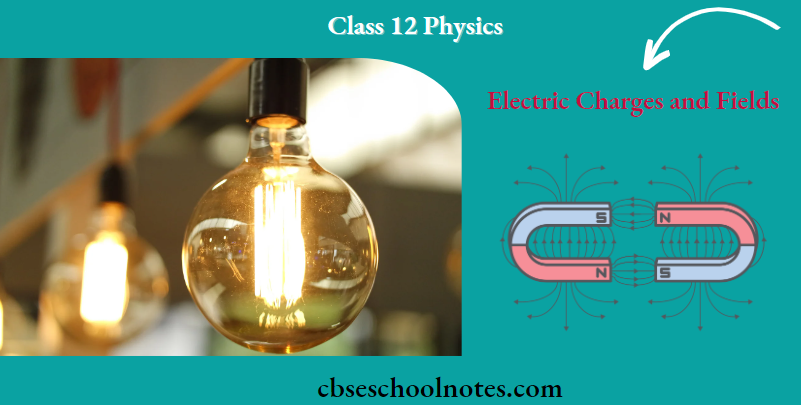
Question 1. An electric dipole placed in a non-uniform electric field will experience:
- Only a force
- Only a torque
- Both force and torque
- Neither force nor torque
Answer: 3. Both force and torque
Read and Learn More Important Questions for Class 12 Physics with Answers
Question 2. Let N1 be the number of electric field lines going out of an imaginary cube of side a that encloses an isolated point charge 2q and N2, be the corresponding number for an imaginary sphere of radius a that encloses an isolated point charge 3q Then (N1/N2) is :
- 1/π
- 2/3
- 9/4
- 5/3
Answer: 2. 2/3
∴ \(\phi=\frac{q}{\varepsilon_0}\)
So, \( N_1 =\frac{2 q}{\varepsilon_0} \)
∴ \(N_2 =\frac{3 q}{\varepsilon_0} \Rightarrow \frac{N_1}{N_2}=\frac{2}{3}\)
Question 3. Let F1 be the magnitude of the force between two small spheres, charged to a constant potential In free space, and F2, be the magnitude of the force between them in a medium of dielectric constant K. Then (F1/F2) is:
- \(\frac{1}{K}\)
- K
- K2
- \(\frac{1}{\mathrm{~K}^2}\)
Answer: 2. k
⇒ \( F_m=\frac{F_0}{K} \)
⇒ \( F_2=\frac{F_1}{K}\)
So, \( $\frac{F_1}{F_2}=K\)
Physics Class 12 Chapter 1 Important Questions Pdf
Question 4. A charge Q is placed at the center of the line joining two charges q and The system of the three charges will be in equilibrium if Q is :
- \(+\frac{q}{3}\)
- \(-\frac{q}{3}\)
- \(+\frac{q}{4}\)
- \(-\frac{q}{4}\)
Answer: 4. \(-\frac{q}{4}\)
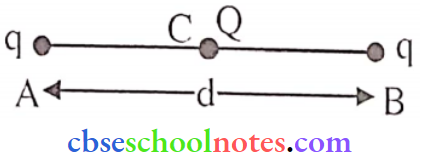
According to question
Fnet = 0
According to q at AB
FAC = FAB
⇒ \(\frac{\mathrm{kqQ}}{\left(\frac{\mathrm{d}}{2}\right)^2}=\frac{\mathrm{kqq}}{\mathrm{d}^2}\)
4Q = q
⇒ \(\mathrm{Q}=\frac{\mathrm{q}}{4}\)
Q must be negative
so, \(\mathrm{Q}=\frac{\mathrm{-q}}{4}\)
Question 5. Electric flux of an electric field E through an area d\(\vec{A}\) is given by :
- \({\vec{E}} \times \mathrm{d} \vec{A}\)
- \(\frac{\vec{E} \times \mathrm{d} \overrightarrow{\vec{A}}}{\varepsilon_0}\)
- \({\vec{E}} \cdot \mathrm{d}{\vec{A}}\)
- \(\frac{\vec{E} \cdot d \vec{A}}{\varepsilon_0}\)
Answer: 3. \({\vec{E}} \cdot \mathrm{d}{\vec{A}}\)
Question 6. Two point charges +16 q and -4 q are located at x = 0, and x = L. The location of the point on the x-axis at which the resultant electric field due to these charges is zero is:
- 8L
- 6L
- 4L
- 2L
Answer: 4. 2L
Physics Class 12 Chapter 1 Important Questions Pdf
Question 7. An electric dipole of dipole moment 4 x 10-5C-m, kept in a uniform electric field of 10-3 NC-1 experiences a torque of 2 x 10-8 Nm. The angle that the dipole makes with the electric field is:
- 30°
- 45°
- 60°
- 90°
Answer: 1. 30°
τ = pE sin θ
Question 8. Three identical charges arc placed at the x-axis from left to right with adjacent charges separated by a distance d. The magnitude of the force on a charge from its nearest neighbor charge is F. Let \(\hat{i}\) be the unit vector along + x-axis. then the net force on each charge from left to right is :
- \((2 F \hat{i},-2 F \hat{i}, 2 F \hat{i})\)
- \((\mathrm{F} \hat{\imath}, 0, \mathrm{~F} \hat{\imath})\)
- \((-5 / 4 F \hat{\imath}, 0,+5 / 4 F \hat{\imath})\)
- \((2 F \hat{\imath}, 0,2 F \hat{\imath})\)
Answer: 3. \((-5 / 4 F \hat{\imath}, 0,+5 / 4 F \hat{\imath})\)
Question 9. A lest charge of 1.6 x 10-19C is moving with a velocity \({\vec{v}}=(4 \hat{\mathrm{i}}+3 \hat{\mathrm{k}}) \mathrm{ms}^{-1}\) in a magnetic field \({\vec{B}}=(3 \hat{\mathrm{k}}+4 \hat{\mathrm{i}}) \mathrm{T}\) The force on this lest charge is:
- \(24 \hat{j} \mathrm{~N}\)
- \(-24 \hat{i} \mathrm{~N}\)
- \(24 \hat{k} \mathrm{~N}\)
- 0
Answer: 4. 0
Question 10. If a charge is moved against a coulomb force of an electric field, then the
- The intensity of the electric field increases
- The intensity of the electric field decreases
- Work is done by the electric field
- Work is done by the external source
Answer: 4. Work is done by the external source
Question 11. A charge Q is located at the center of a circle of radius r. The work done in moving a test charge q0 from point A to point B (at opposite ends of diameter AB) to complete a semicircle is \(\left[k=\frac{1}{4 \pi \varepsilon_0}\right]\)
- \(k \frac{q_0 Q}{r}\)
- \(k \frac{q_0 Q}{r^2}\)
- kq0Qr
- Zero
Answer: 4. Zero
Physics Class 12 Chapter 1 Important Questions Pdf
Question 12. Two charged spheres A and B having their radii in ratio 1: 2 are connected with a conducting wire, the ratio of their surface charge densities (σA/ σB) will be:
- \(\frac{1}{2}\)
- 2
- \(\frac{1}{4}\)
- 4
Answer: 2. 2
Question 13. The force acting between two point charges kept at a certain distance is 5 N. Now the magnitudes of charges arc doubled and the distance between them is halved, the force acting between them is _______ N.
- 5
- 20
- 40
- 80
Answer: 4. 80
\(F=\frac{k q \cdot q}{r^2}=5 \)Now, \(F=\frac{k(2 q)(2 q)}{\left(\begin{array}{l}
r \\
2
\end{array}\right)^2}\) = 16 x 5 = 80 N
Question 14. When an electron and a proton are placed in an electric field _________.
- The electric forces acting on them are equal in magnitude as well as direction.
- Only the magnitudes of forces are the same.
- Accelerations produced in them are the same
- The magnitudes of accelerations produced in them are the same
Answer: 2. Only the magnitudes of forces are the same.
Question 15. Two spheres carrying charges q arc hanging from, the same point of suspension with the threads of length 2 m, in space free from gravity. The distance between them will be, ______ m.
- 0
- 1.0
- 4.0
- 2.0
Answer: 3. 4.0

Question 16. When two spheres having 2Q and -Q are placed at a certain distance. The force acting between them is F. Now these are connected by a conducting wire and again separated from each other. How much, force will act between them if the separation, now is the same as before?
- F
- \(\frac{F}{2}\)
- \(\frac{F}{4}\)
- \(\frac{F}{8}\)
Answer: 4. \(\frac{F}{8}\)

⇒ \(\mathrm{F}=\frac{2 \mathrm{k} \mathrm{Q}^2}{\mathrm{r}^2}\) →(1)
These are connected after the separation
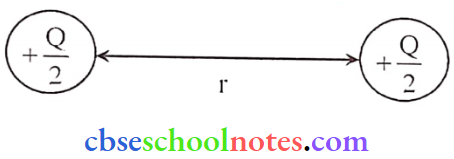
⇒ \(\mathrm{F}^{\prime}=\frac{\mathrm{k}\left(\frac{\mathrm{Q}}{2}\right)\left(\frac{\mathrm{Q}}{2}\right)}{\mathrm{r}^2}=\frac{\mathrm{kQ}^2}{4 \mathrm{r}^2}\) →(2)
Equation (2)÷(1)
∴ \(\frac{F^{\prime}}{F}=\frac{1}{8} \Rightarrow F^{\prime}=\frac{F}{8}\)
Physics Class 12 Chapter 1 Important Questions Pdf
Question 17. When a 10 μC charge is enclosed by a closed surface, the flux passing through the surface is Φ. Now another -5μC charge is placed inside the same closed surface, then the flux passing through the surface is ________.
- 2Φ
- Φ/2
- Φ
- Zero
Answer: 2. Φ/2
Question 18. An electric dipole is placed in a uniform electric field. The resultant force acting on it is _________.
- Always zero
- Never zero
- Depends on the relative position
- Depends upon the dipole moment
Answer: 1. Always zero
Question 19. Electric field due to a dipole at a large distance (r) falls off as ________.
- \(\frac{1}{r}\)
- \(\frac{1}{r^2}\)
- \(\frac{1}{r^3}\)
- \(\frac{1}{r^4}\)
Answer: 3. \(\frac{1}{r^3}\)
⇒ \(E=\frac{2 k p}{r^3}\) (On axis)
∴ \(\mathrm{E}=\frac{\mathrm{kp}}{\mathrm{r}^3}\) (on equator for large distance)
Question 20. The resultant force and resultant torque acting on an electric dipole kept in a uniform electric Held (θ ≠ 0° or 180°) are \(\vec{F}\) and \(\vec{\tau}\) then:
- \({\vec{F}} \neq 0 ; \quad \vec{\tau}=0 \)
- \({\vec{F}}=0 ; \quad \vec{\tau} \neq 0\)
- \({\vec{F}}=0 ; \vec{\tau}=0\)
- \(\dot{\vec{F}} \neq 0 ; \vec{\tau} \neq 0\)
Answer: 2. \({\vec{F}}=0 ; \quad \vec{\tau} \neq 0\)
Question 21. The liquid drop of mass ‘m’ has a charge ‘q’. What should be the magnitude of electric field E to balance this drop?
- \(\frac{E}{m}\)
- \(\frac{\mathrm{mg}}{\mathrm{q}}\)
- mgq
- \(\frac{\mathrm{mq}}{\mathrm{g}}\)
Answer: 2. \(\frac{\mathrm{mg}}{\mathrm{q}}\)
∴ mg = qE
Question 22. The number of electric field lines that emerged from 1 mC charge is _____.
- 1.13×102
- 9×109
- 1.13×1011
- 9×10-9
Answer: 1. 1.13×102
∴ \(\phi=\frac{\mathrm{q}}{\varepsilon_0}=\frac{1 \mathrm{mC}}{8.85 \times 10^{-12}}=1.13 \times 10^8 \frac{\mathrm{N}}{\mathrm{C}} \times \mathrm{m}^2\)
Physics Class 12 Chapter 1 Important Questions Pdf
Question 23. A charge Q is enclosed by a Gaussian spherical surface of radius R. If the radius is doubled, the outward electric flux will:
- Increase four times
- Be reduced to half
- Remains The same
- Be doubled
Answer: 3. Remains The same
Physics Class 12 Chapter 1 Important Questions Assertion And Reason
For questions numbers 1 to 4 two statements are given-one labeled Assertion (A) and the other labeled Reason (R). Select the correct answer to these questions from the codes (1), (2), (3), and (4) as given below.
- Both A and R are true and R is the correct explanation of A
- Both A and R are true but R is NOT the correct explanation of A
- A is true but R is false
- A is false and R is also false
Question 1. Assertion: In electrostatics, electrostatic field lines can never be closed loops.
Reason: The number of electric field lines originating from or terminating on a charge is
proportional to the magnitude of the charge.
Answer: 2. A is true but R is false
Question 2. Assertion: Under electrostatic conditions net electric field inside a solid conductor will be zero.
Reason: Under electrostatics conditions, there will be no free electrons inside a conductor.
Answer: 3. Both A and R are true but R is NOT the correct explanation of A
Question 3. Assertion: Gauss law shows diversion when inverse square law is not obeyed.
Reason: Gauss law is a consequence of conservation of charge.
Answer: 3. A is true but R is false
Question 4. Assertion: The electrostatic force between two charges is a nonconservative force.
Reason: Electric force between two charges proportional to the square of distance between the two.
Answer: 4. A is false and R is also false
Question 5. Assertion: Electrostatic field lines are perpendicular to the surface of the conductor.
Reason: The surface of a conductor is equipotential.
Answer: 1. Both A and R are true and R is the correct explanation of A
Physics Class 12 Chapter 1 Short Questions And Answers
Question 1. Derive an expression for the work done in rotating a dipole from the angle θ0 to θ1, in a uniform electric field.
Answer:

As we know, when a dipole is placed in a uniform electric field, the net force on the dipole is zero but it experiences a torque, which can be given as, \(\vec{\tau}=\vec{p} \times \vec{E}\)
This torque rotates the dipole unless it is placed parallel or anti-parallel to the external field. If we apply an external and opposite torque, it neutralizes the effect of this torque given by τext and it rotates the dipole from the angle θ0 to an angle θ1 at an infinitesimal angular speed without any angular acceleration.
The amount of work done by the external torque can be given by
∴ \(\mathrm{W}=\int_{0_{0}}^{0_1} \tau_{\mathrm{cxt}} \mathrm{d} 0=\int_{0_0}^{0_1} p E \sin 0 \mathrm{~d} 0=p \mathrm{E}\left(\cos \theta_0-\cos \theta_1\right)\)
Question 2.
- Draw the pattern of electric field lines due to an electric dipole.
- Write any two properties of electric field lines.
Answer:
1. 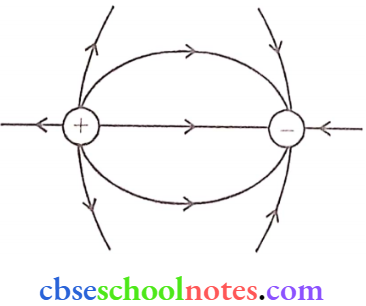
2. Field lines of the electrostatic field have the following properties:
- Never intersect each other.
- Electrostatic field lines never form closed loops.
Question 3. A system has two charges qA = 2.5 x 10-7C and qB = – 2.5 x 10-7C located at points A : (0, 0, -15 cm) and B : (0, 0, +15 cm), respectively. What is the total charge and electric dipole moment of the system?
Answer:
Total charge = 2.5 x 10-7– 2.5 x 10-7 = 0
Electric dipole moment is \(\overrightarrow{\mathrm{p}}=\mathrm{q}(2 \overrightarrow{\mathrm{a}})\)
= 2.5×10-7x (0.15+0.15) C-m
= 7.5×108 C-m
The direction of the dipole moment is along the Z-axis.
Question 4. Find the expression for torque experienced by an electric dipole in a uniform electric field.
Answer:
Torque on an electric dipole in a uniform electric field

We consider a dipole with charges +q and -q which are at a distance d away from each other. Let it be placed in a uniform electric field of strength E such that the axis of the dipole forms an angle 0 with the electric field.
The force on the charges is
F+q = +qE → towards the direction of the electric field
F-q = -qE → opposite to the direction of the electric field
Since the magnitudes of forces are equal and they are separated by a distance d,
The torque on the dipole is given by :
Torque (τ) = Force x perpendicular distance between both forces
τ = F.d sin 0
or τ = qEdsinO
So τ = pE .sin 0 (p = qd)
or \(\vec{\tau}=\vec{p} \times \vec{E}\) [in vector form]
Question 5.
- Define electric flux Write its SI Unit.
- How does the electric flux due to a point charge enclosed by a spherical Gaussian surface get affected when its radius is increased?
Answer:
1. Electric flux is proportional to the number of electric field lines passing through a given area.
It is numerically equal to the dot product of the electric field and area vector.
Φ = A (Ecosθ)
⇒ \(\phi={\vec{E}} \cdot {\vec{A}}\)
The electric flux through an area is the dot product of the magnitude of \(\vec{E}\) and \(\vec{A}\).
The S.I. unit of ‘electric flux’ is N-m2C-1 or V-m.

2. Wc knows that flux through the Gaussian surface is given by \(\phi=q / \varepsilon_0\)
As flux is independent of radius, it is not affected by changing the radius.
Question 6.
1. A uniformly charged large plane sheet has charge density \(\sigma=\left(\frac{1}{18 \pi}\right) \times 10^{-15} \mathrm{C} / \mathrm{m}^2\). Find the electric field at point A which is 50 cm from the sheet. Consider a straight line with three points P. Q and R, placed 50 cm from the charged sheet on the right side as shown in the figure. At which of these points, does the magnitude of the electric field due to the sheet remain the same as that at point A and why?
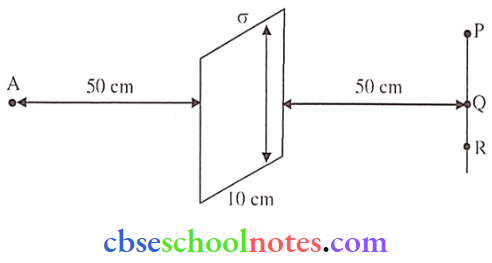
2. Two small identical conducting spheres carrying charge 10 μC and- 20μC when separated by a distance r, experience a force F each. If they are brought in contact and then separated to a distance of \(\frac{r}{2}\), what is the new force between them in terms of F?
Answer:
1. \(E=\frac{\sigma}{2 \varepsilon_0}=\frac{1}{18 \pi} \times \frac{10^{-15}}{2 \times 1} \times 4 \pi \mathrm{k}\) (\(k=\frac{1}{4 \pi \varepsilon_0}\))
= \(\frac{1}{9} \times 10^{-15} \times 9 \times 10^9\)
= 10-6 V/m
Point →Q, Because at 50 cm, the charge sheet acts as a finite sheet, and thus the magnitude
remains the same towards the middle region of the planar sheet.
2. 
According to Coulomb’s Law
⇒ \(\mathrm{F}=\frac{\mathrm{k}(10 \mu \mathrm{C})(20 \mu \mathrm{C})}{\mathrm{r}^2}\)
⇒ \(\mathrm{F}=\frac{2 \times 9 \times 10^9 \times 100 \times 10^{-12}}{\mathrm{r}^2}\)
⇒ \(F=\frac{1.8}{r^2}\) →(1)
After contact

⇒ \(F^{\prime}=\frac{k(-.5 \mu C)(-.5 \mu C)}{\left(\begin{array}{l}
r{\prime} \\
2\end{array}\right)^2}\)
⇒ \(F^{\prime}=\frac{4 \times 9 \times 10^{11} \times 2.5 \times 10^{-12}}{r^2}\)
∴ \(F^{\prime}=\frac{0.9}{r^2}\) →(2)
So, \(F^{\prime}=\frac{F}{2}\)
Question 7. A charge is distributed uniformly over a ring of radius ‘a’. Obtain an expression for the electric intensity \(\vec{E}\) at a point on the axis of the ring. Hence shows that for points at a large distance from the ring, it behaves like a point charge.
Answer:
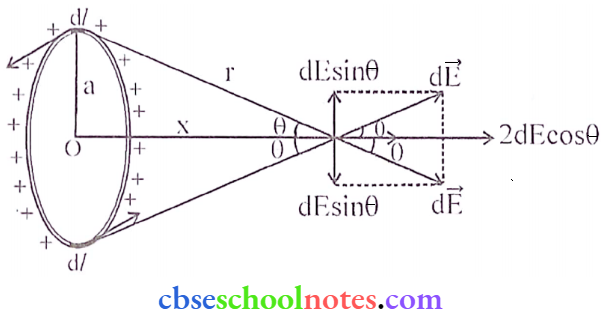
Suppose that the ring is placed with its plane perpendicular to the x-axis. as shown in the above diagram. We consider a small element dl of the ring. So the charge dq on the element dl is
⇒ \(\mathrm{dq}=\frac{\mathrm{q}}{2 \pi \mathrm{a}} \mathrm{d} l\) [∵ \(\lambda=\frac{\mathrm{q}}{2 \pi \mathrm{a}}\)] = charge per unit length
∴ The magnitude of the field de has two components:
- The axial component ⇒ dEcosθ
- The perpendicular component ⇒ dEsinθ
Since the perpendicular components of any two diametrically opposite elements are equal and opposite, they all cancel out in pairs. Only the axial components will add up to produce the resultant field at point P, which is given by,
⇒ \(\mathrm{E}=\int_0^{2 \pi \mathrm{a}} \mathrm{d} \mathrm{E} \cos \theta\)
⇒ \(\mathrm{E}=\int_0^{2 \pi \mathrm{a}} \frac{\mathrm{kq}}{2 \pi \mathrm{a}} \frac{\mathrm{d}
l}{\mathrm{r}^2}\left(\frac{\mathrm{x}}{\mathrm{r}}\right)=\frac{\mathrm{kqx}}{2 \pi \mathrm{ar}^3} \int_0^{2 \pi \mathrm{a}} \mathrm{d} l\) [∵ \(\cos \theta=\frac{x}{r}\)]
∴ \(\mathrm{E}=\frac{\mathrm{kqx}}{2 \pi \mathrm{ar}^3}[l]_0^{2 \pi \mathrm{a}}=\frac{\mathrm{kqx}}{2 \pi \mathrm{a}} \frac{1}{\left(\mathrm{x}^2+\mathrm{a}^2\right)^{3 / 2}}(2 \pi \mathrm{a}) \quad\left[\mathrm{as}^2=\mathrm{x}^2+\mathrm{a}^2\right]\)
or \(\mathrm{E}=\frac{\mathrm{kqx}}{\left(\mathrm{x}^2+\mathrm{a}^2\right)^{3 / 2}}=\frac{1}{4 \pi \varepsilon_0} \frac{\mathrm{qx}}{\left(\mathrm{x}^2+\mathrm{a}^2\right)^{3 / 2}}\)
Special case: For points at large distance from the ring x >> a
∴ \(E=\frac{k q}{x^2}=\frac{1}{4 \pi \varepsilon_0} \frac{q}{x^2}\)
Tins are the same as the field due to a point charge, indicating that for far-off axial points, the charged ring behaves as a point charge.
Question 8. Two large, thin metal plates are parallel and close to each other. On their inner faces, the plates have surface charge densities of opposite signs and of magnitude 17.0 x 10-22 C/m2. What is electric field intensity:
- In the outer region of the first plate.
- In the outer region of the second plate, and
- Between the plates?
Answer:

Where. EP = Electric field due to Plate P
EQ = Electric field due to Plate Q
1. In the outer region of the first plate
⇒ \(E_1=E_P-E_Q=\frac{\sigma_P-\sigma_Q}{2 \varepsilon_0}\)
= \(\frac{17 \times 10^{-22}-17 \times 10^{-22}}{2 \varepsilon_0}\) = E1 = 0 (i.e Electric field is zero)
2. Similarly, the electric field is zero in this case also E11 = EP– EQ = 0
3. Between the plates
⇒ \(\mathrm{E}_{\mathrm{3}}=\mathrm{E}_{\mathrm{P}}+\mathrm{E}_{\mathrm{Q}}=\frac{\sigma_{\mathrm{P}}+\sigma_{\mathrm{Q}}}{2 \varepsilon_0}\)
= \(\frac{17 \times 10^{-22}+17 \times 10^{-22}}{2 \varepsilon_0}\)
∴ \(\mathrm{E}_{3}=\frac{34 \times 10^{-22}}{2 \times 8.854 \times 10^{-12}}=1.92 \times 10^{-10} \mathrm{NC}^{-1}\)
Question 9. Derive an expression for the electric field intensity at a point on the equatorial line of an electric dipole of dipole moment \(\vec{P}\) and length 2a. What is the direction of this field?
Answer:
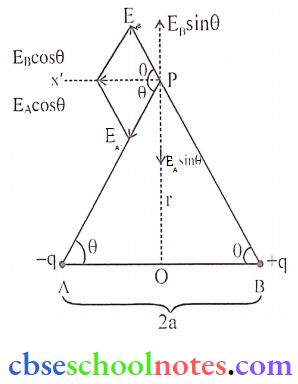
We consider a dipole consisting of -q and +q separated by a distance 2a. Let P be a point on the equatorial line.
⇒ \({\vec{E}}_{\mathrm{A}}=\frac{\mathrm{l}}{4 \pi \varepsilon_0} \frac{\mathrm{q}}{(\mathrm{AP})^2} \text { along } \vec{PA}\)
⇒ \(E_A=\frac{1}{4 \pi \varepsilon_0} \frac{q}{\left(r^2+a^2\right)}\)
⇒ \({\vec{E}}_{\mathrm{B}}=\frac{1}{4 \pi \varepsilon_0} \frac{\mathrm{q}}{(\mathrm{BP})^2} \text { along } \vec{BP}\)
∴ \(E_B=\frac{1}{4 \pi \varepsilon_0} \frac{q}{\left(r^2+a^2\right)}\)
The resultant intensity is the vector sum of the intensities along PA and BP. EA and EB can be resolved into vertical and horizontal components. The vertical components of EA and EB cancel each other as they are equal and oppositely directed. So the horizontal components add up to the resultant field.
E = EA cos θ + EB cos θ
E = 2EAcosθ , as EA = EB
Substituting, \(\cos \theta=\frac{a}{\left(r^2+a^2\right)^{\frac{1}{2}}}\) in the above equation
⇒ \(E=2 E_A \cos \theta=\frac{2}{4 \pi \varepsilon_0} \frac{q}{\left(r^2+a^2\right)} \frac{a}{\left(r^2+a^2\right)^{\frac{1}{2}}}\)
∴ \(\mathrm{E}=\frac{\mathrm{kp}}{\left(\mathrm{r}^2+\mathrm{a}^2\right)^{\frac{3}{2}}}\)along \(\overrightarrow{\mathrm{BA}}\) (As p+qx2a)
As a special case,
If a2<<r2 then, \(E=\frac{k p}{r^3}\) along \(\overrightarrow{\mathrm{BA}}\)
Electric field intensity at an axial point is twice the electric field intensity on the equatorial line.
The direction of the field will be against the direction of the dipole moment.
Question 10. Four point charges Q, q, Q, and q are placed at the corners of a square of side ‘a’ as shown in the figure.
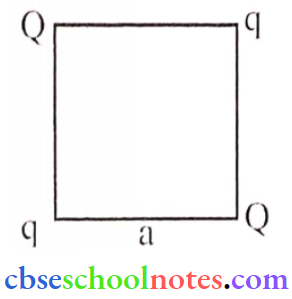
Find the resultant electric force on a charge Q
Answer:
Let us find the force on the charge Q at the point C. Force due to the other charge Q
∴ \(\mathrm{F}_1=\frac{1}{4 \pi \varepsilon_0} \frac{\mathrm{Q}^2}{(\mathrm{a} \sqrt{2})^2}=\frac{1}{4 \pi \varepsilon_0}\left(\frac{\mathrm{Q}^2}{2 \mathrm{a}^2}\right)\) (along AC)

Force due to the charge q placed at B
⇒ \(\mathrm{F}_2=\frac{1}{4 \pi \varepsilon_0} \frac{\mathrm{qQ}}{\mathrm{a}^2} \text { along } \mathrm{BC}\)
Force due to the charge q placed at D
⇒ \(F_3=\frac{1}{4 \pi \varepsilon_0} \frac{\mathrm{qQ}}{\mathrm{a}^2} \text { along } \mathrm{DC}\) along DC
Resultant of these two equal forces F2 and F3
⇒ \(\mathrm{F}_{23}=\frac{1}{4 \pi \varepsilon_0} \frac{\mathrm{qQ}(\sqrt{2})}{\mathrm{a}^2} \text { (along } \mathrm{AC} \text { ) }\)
∴ The net force on charge Q (at point C)
⇒ \(F=F_1+F_{23}=\frac{1}{4 \pi \varepsilon_0} \frac{Q}{\mathrm{a}^2}\left[\frac{Q}{2}+\sqrt{2} \mathrm{q}\right]\)
This force is directed along the AC
(For the charge Q, at the point A, the force will have the same magnitude but will be directed along CA)
Physics Class 12 Chapter 1 Important Long Questions And Answers
Question 1. When an electric dipole is placed in a uniform electric field, its two charges experience equal and opposite forces, which cancel each other and hence net force on the electric dipole in a uniform electric field is zero. However, these forces are not collinear, so they give rise to some torque on the dipole. Since the net force on an electric dipole in a uniform electric field is zero. So no work is done in moving the electric dipole in a uniform electric field. However, some work is done in rotating the dipole against the torque acting on it.
- The dipole moment of a dipole in a uniform external field \(\vec{E}\) is \(\vec{p}\). Write the expression of torque acting on the dipole.
- An electric dipole consists of two opposite charges, each of magnitude 1.0 μC separated by a distance of 2.0 cm. The dipole is placed in an external field of 105 NC-1. Find the value of max Torque.
- Write the value of angle θ, when τ is minimum.
- When an electric dipole is held at an angle θ (θ ≠ 0° or 180°) in a uniform electric field Write the value of net force \(\vec{F}\) and torque \(\vec{\tau}\)?
Answer:
1. \(\vec{\tau}=\vec{p} \times \vec{E}\)
2. \(\tau=P E \sin 90^{\circ}=p E=1 \times 10^{-6} \times 2 \times 10^{-2} \times 10^5=10^{-3} \mathrm{~N} . \mathrm{m}\)
3. 0° or 180° or nπ
4. F = 0, τ ≠ 0
Question 2. Concept of Electric field
An electric field is an elegant way of characterizing the electrical environment of a system of charges. An electric field at a point in the space around a system of charges tells you the force a unit-positive test charge would experience if placed at that point (without disturbing the system). The electric field is a characteristic of the system of charges and is independent of the last charge that you place at a point to determine the field
- Write one property of electric field lines
- Define electric field intensity.
- The SI unit of the electric field is_______
- A proton of mass ‘m’ placed in the electric field region remains stationary in the air. What is the magnitude of the electric field?
Answer:
- The electric field line starts from +ve charge and ends at -ve charge.
- It is defined as the electric force experienced per unit positive test charge is known as electric field intensity.
- N/C and V/m
- mg = eE
E = mg/c
Question 3.
- Use Gauss’ law to derive the expression for the electric field \((\vec{E})\) due to a straight uniformly charged infinite line of charge density λ C/m.
- Draw a graph to show the variation of E with perpendicular distance r from the line of
charge. - Find the work done in bringing a charge q at a perpendicular distance from co-long charged
wire r1, to r2, (r2 > r1).
Answer:
1. To calculate the electric field, imagine a cylindrical Gaussian surface, since the field is everywhere radial, flux through two ends of the cylindrical Gaussian surface is zero. At the cylindrical part of the surface electric field E is normal to the surface at every point and its magnitude is constant. Therefore flux through the Gaussian surface.
= Flux through the curved cylindrical part of the surface.
= E x 2πl → (1)
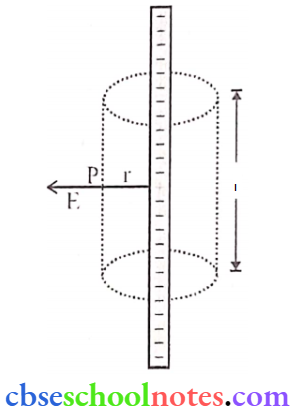
Applying Gauss’s Law
⇒ \(\text { Flux } \phi=\frac{q_{\text {enclosed }}}{\varepsilon_0}\)
Total charge enclosed
= Linear charge density x l = xl
∴ \(\phi=\frac{\lambda l}{\varepsilon_0}\) → (2)
Using Equations (1) and (2)
∴ \(\mathrm{E} \times 2 \pi \mathrm{r} l=\frac{\lambda l}{\varepsilon_0} \Rightarrow \overrightarrow{\mathrm{E}}=\frac{\lambda}{2 \pi \varepsilon_0 \mathrm{r}} \hat{\mathrm{n}}\)
(where \(\hat{n}\) is a unit vector normal to the line charge)
2. The required graph is as shown :
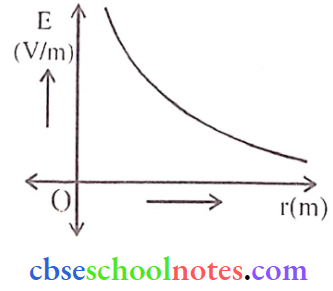
3. Work done in moving a charge q with displacement ‘dr’
⇒ \(\mathrm{dW}=\overrightarrow{\mathrm{F}} \cdot \mathrm{d} \overrightarrow{\mathrm{r}}\)
⇒ \(\mathrm{dW}=\mathrm{q} \overrightarrow{\mathrm{E}} \cdot \mathrm{d} \overrightarrow{\mathrm{r}}=\mathrm{q} \mathrm{Edr} \cos θ\)
⇒ \(\mathrm{dW}=\mathrm{q} \times \frac{\lambda}{2 \pi \varepsilon_0 \mathrm{r}} \mathrm{dr} \)
Work done in moving the given charge from r1 to r2 (r2 > r1)
⇒ \(\int_{r_1}^{r_2} d W=\int_{r_1}^{r_2} \frac{\lambda q d r}{2 \pi \varepsilon_0 r}\)
⇒ \(\mathrm{W}=\frac{\lambda \mathrm{q}}{2 \pi \varepsilon_0}\left[\log _{\mathrm{e}} \mathrm{r}_2-\log _{\mathrm{e}} \mathrm{r}_1\right]\)
∴ \(\mathrm{W}=\frac{\lambda \mathrm{q}}{2 \pi \varepsilon_0}\left[\log _{\mathrm{e}} \frac{\mathrm{r}_2}{\mathrm{r}_1}\right]\)
Question 4. Define electric flux. Is it a scalar or a vector quantity?
1. A point charge q is at a distance of d/2 directly above the center of a square of side d, as shown in the figure. Use Gauss’ law to obtain the expression for the electric flux through the square.
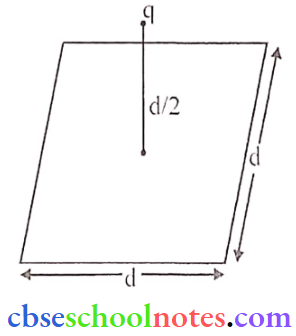
2. If the point charge is now moved to a distance ‘d’ from the center of the square and the side of the square is doubled, explain how the electric flux will be affected.
Answer:
1. Electric flux through a given surface is defined as the dot product of the electric field and area vector over that surface.
Alternatively \(\phi=\int \vec{E} \cdot d \vec{S}\)
Also, accept
Electric flux, through a surface, equals the surface integral of the electric field over a closed surface. It is a scalar quantity.
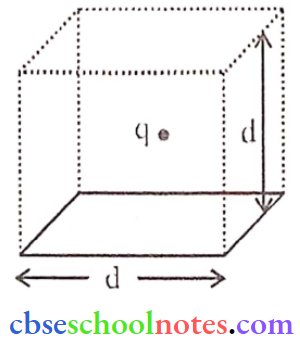
Constructing a cube of side ‘d’ so that charge ‘q’ is placed within this cube (Gaussian surface)
According to Gauss’ law the Electric flux \(\phi=\frac{\text { charge enclosed }}{\varepsilon_0}=\frac{\mathrm{q}}{\varepsilon_0}\)
This is the total flux. through all the six faces of the cube.
Hence electric flux through the square \(\frac{1}{6} \times \frac{q}{\varepsilon_0}=\frac{q}{6 \varepsilon_0}\)
2. If the charge is moved to distance d and the side of the square is doubled even then the total charge enclosed in it will remain the same. Hence the total flux will remain the same as before.
Question 5.
- Derive an expression for the electric field E due to a dipole of length ‘2a’ at a point distant r from the center of the dipole on the axial line.
- Draw a graph of E versus r for r >> a.
- If this dipole were kept in a uniform external electric field E0, with the help of a diagram represent the position of the dipole in stable and unstable equilibrium and write the
expressions for the torque acting on the dipole in both cases.
Answer:
1. Let’s consider a dipole system,

Here, AO = OB = a
OP = r
BP = r-a
AP = r + a
Elec, field (\(\overrightarrow{\mathrm{E}}_{\mathrm{B}}\)), due to the charge at point ‘B’ being towards ‘P’
Elec, field (\(\overrightarrow{\mathrm{E}}_{\mathrm{A}}\)), due to the charge at point ‘A’ being opposite to ‘P’
Now, according to the superposition principle,
⇒ \(\overrightarrow{\mathrm{E}}_{\mathrm{p}}=\overrightarrow{\mathrm{E}}_{\mathrm{ix} \mathrm{axial}}=\overrightarrow{\mathrm{E}}_{\Lambda}+\overrightarrow{\mathrm{E}}_{\mathrm{B}}\)
EP = EB-EA
⇒ \(E_p=\frac{-k q}{(r+a)^2}+\frac{k q}{(r-a)^2}=k q\left[\frac{1}{(r-a)^2}-\frac{1}{(r+a)^2}\right]=k q\left[\frac{(r+a+r-a)(r+a-r+a)}{(r-a)^2(r+a)^2}\right]\)
=\(\frac{k q(2 r)(2 a)}{\left(r^2-a^2\right)^2}\)
⇒ \(E_{a x i a l}=\frac{2 r k(2 a)(q)}{\left(r^2-a^2\right)^2}\) [∵ \(|\overrightarrow{\mathrm{p}}|=2 \mathrm{a} \times \mathrm{q}\)] = \(\frac{2 \mathrm{kpr}}{r^{4}}\)
if a2 << r2 then \(\dot{\vec{E}}_{\mathrm{axial}}=\frac{2 \mathrm{k} {\vec{p}}}{\mathrm{r}^3}\)
It will be directed in the direction of electric dipole moment, \(\vec{P}\).
2. 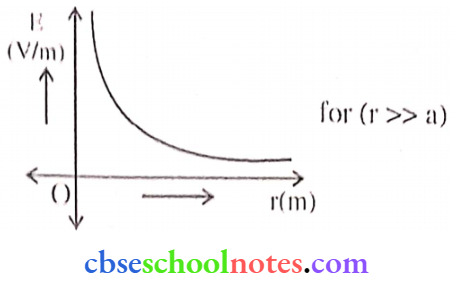
3. (1). Stable equilibrium

Torque (τ) = pEsinθ
= pE x sinθ° = 0 (vsinθ° = 0)
(2). Unstable equilibrium

Torque (τ) = pE sinθ
= pE sin 180°
= pE x 0 = 0 (∵ sin 180° = 0)
Question 6.
- Use Gauss’ theorem to find the electric field due to a uniformly charged infinitely large plane thin sheet with surface charge density σ.
- An infinitely large thin plane sheet has a uniform surface charge density +σ. Obtain the expression for the amount of work done in bringing a point charge q from infinity to a point distant r, in front of the charged plane sheet.
Answer:
1. 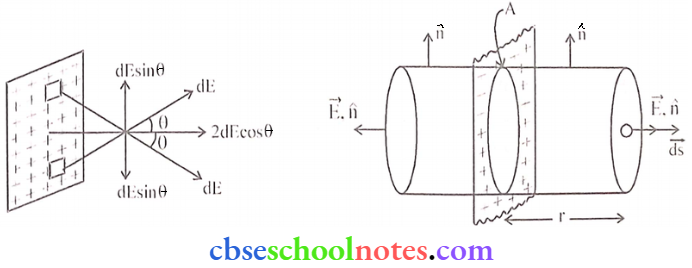
As shown in the figure, considering a cylindrical Gaussian surface of cross-section A
Flux through the curved surface :
∴ \(\phi=\int \overrightarrow{\vec{E}} \cdot \mathrm{d} {\vec{S}}=\int \mathrm{Eds} \cos 90^{\circ}=0\)
At the points on the curved surface, the field vector E and area vector dS make an angle of 90° with each other. Therefore, curved surfaces do not contribute to the flux.
Flux through end caps :
∴ \(\phi=\oint \vec{E} \cdot \mathrm{dS}=\oint \mathrm{EdS} \cos 0^{\circ}=\mathrm{EA}\)
Hence, the total flux through the closed surface is :
Φ = Flux through both end caps + flux through curved surface
or Φ = EA + EA + 0 = 2EA → (1)
Now according to Gauss’ law for electrostatics
⇒ \(\phi=q / \varepsilon_0\) → (2)
Comparing equations (1) and (2), we get
2EA = q/ε0
E = q/2ε0A → (3)
The area of the sheet enclosed in the Gaussian cylinder is also A. Therefore, the charge contained in the cylinder, q = σA as a (surface charge density) = q/A.
Substituting this value of q in equation (3), we get
E = σA/2ε0A
or E = σ/2ε0
This is the relation for the electric field due to an infinite plane sheet of charge. The field is uniform and does not depend on the distance from the plane sheet of charge.
2. \(V=\frac{W}{c}=\int_{\infty}^r \vec{E} \cdot d \vec{r}\)
⇒ \(\mathrm{W}=\mathrm{c} \int_{\infty}^{\mathrm{r}}(-\mathrm{Edr})\)
⇒ \(W=-q \int_{\infty}^r \frac{\sigma}{2 c_0} d r\)
∴ \(W=\frac{q \sigma}{2 \varepsilon_0}(\infty-r)\) W = ∞
